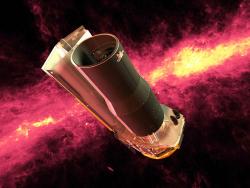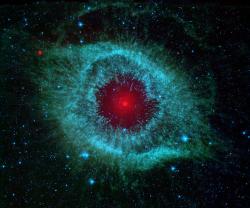Spitzer Space Telescope (SST)

Credit: NASA/JPL-Caltech
The Spitzer Space Telescope (SST) was a NASA infra-red telescope. The goal of the mission was to view the Universe in infra-red light. This would reveal parts of space which are hidden from visible light telescopes. The mission lasted from 2003 to 2020.
Spitzer was put into an orbit following the Earth around the Sun. Water molecules in the Earth's atmosphere absorb a lot infra-red light from space. This means that most infra-red telescopes are placed at very high altitudes or in space, like Spitzer.
Spitzer used its infra-red cameras to make images of stars forming, planets forming, far off galaxies, and distant quasars. In 2005, Spitzer was first telescope to capture light reflecting off an exoplanet. Spitzer was not able to create an image of the planet, but it was the first time a planet outside our Solar System had ever been directly detected.

Credit: NASA/JPL-Caltech
The Spitzer mission was planned to last for 5 years. The telescope used liquid helium to cool its instruments to low temperatures. They needed to be cool in order to detect infra-red light (or heat) from objects in space. Spitzer was launched with enough liquid helium to last 5 years. Without this cooling system, most of the telescope's instruments no longer worked. However, two of its instruments did work until 2020. This phase was called the Spitzer Warm Mission.

